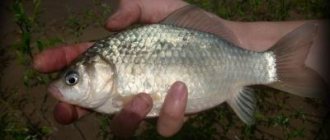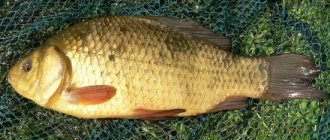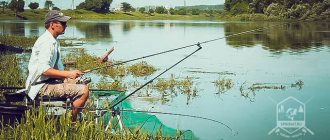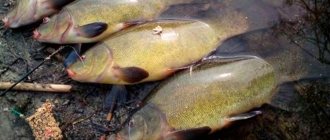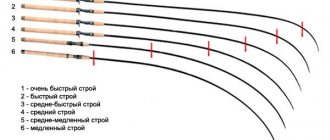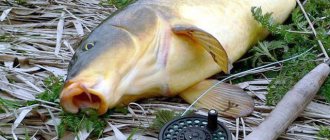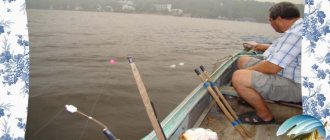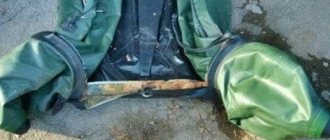Fishing with an onboard rod from a boat is a very productive fishing activity that is accessible to everyone. Most often, its target is bream. But you can catch other fish in this way - ide, crucian carp, carp and so on.
Many people prefer to fish only from the shore. But the results of fishing from a boat are much better. So it wouldn’t hurt for every real fisherman to learn how to use a watercraft. There is nothing complicated in controlling it, as well as in the technique of fishing with onboard tackle.
Advantages of fishing with a side rod
There are many advantages to fishing with a side line that make this type of fishing worth paying attention to.
Using a watercraft, you can stand directly above a promising area, accurately feed it and accurately present the bait.
If when fishing from the shore the fish often have to be dragged several tens of meters, then when fishing from a boat this distance usually does not exceed 10 meters.
Thanks to all this, the chances of good catches are much greater. A side rod is the best tackle for fishing in the deep water where the good fish are holding.
With the help of a boat and an echo sounder, you can quickly examine any areas of the reservoir to find promising ones. When fishing from the shore there is no such opportunity.
A side fishing rod is a compact piece of equipment that easily fits in a backpack. It makes it convenient to travel by public transport to a body of water where you have a boat or where you can rent one.
It is easy to make a side fishing rod with your own hands. It will be quite inexpensive.
Boat fishing technique
The task of the fisherman, who knows the promising sites for the predator, and who has prepared his gear, is to provoke the fish to attack the bait. You can provoke it using special spinning bait wiring.
Here are the basic techniques for fishing from a boat:
- When fishing for predators in standing waters, the spinning angler’s task is to lure fish out of their ambushes: coastal thickets, water lilies. To do this, the bait is placed along a wall of plants in various ways: uniform, with pauses, twitching, jig.
- For catching predators on the river, the main wiring is a jig. Only this method can catch deep holes where living creatures are hidden.
- When catching peaceful fish using feeder gear, the main point is feeding. This needs to be done often, and casts should be made to the same place. The consistency of the bait should be such that the contents of the feeder are washed out within approximately 10 minutes.
Gear structure and equipment options
The onboard fishing rod consists of:
- short fishing rod with a handle;
- coil located on it;
- nod;
- fishing lines with equipment.
This type of tackle is similar to a fishing rod for trolling a predator from the ice. Suitable length of gear is up to 1.5 m.
Usually 2-3 fishing rods are used. Then the chances of a good catch are higher than with one tackle. The more hooks with bait are thrown into the water, the higher the likelihood that one of them will be found by a fish.
And also when fishing with several fishing rods, you can try different baits to quickly determine which one will be more attractive.
Coil selection
Fishing with a side rod from a boat usually does not involve the use of a reel while fishing. Its only function is to serve as a receptacle for fishing line. A simple inertia, plastic or metal, will be enough.
But there is another approach to fishing with a side rod. It involves catching fish using a reel. This option is suitable for hunting trophy specimens - catching large bream, carp, carp, pike, pike perch and others.
The reel will help you confidently cope with such fish. For such fishing, you can equip onboard fishing rods with high-quality spinning rods with good friction brakes.
Nod for onboard fishing rod
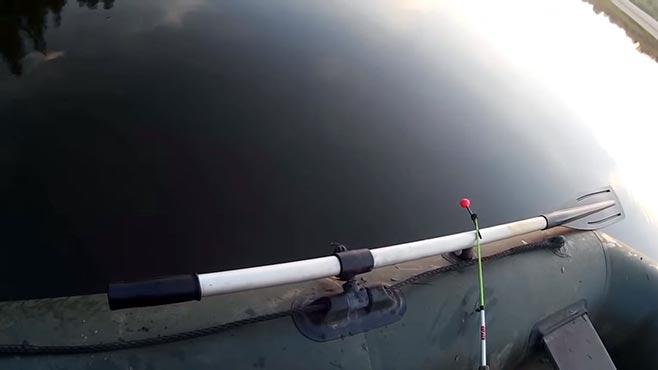
Nods can be different - rubber, twisted steel springs and other materials. Since there is no need for a complex technical game when fishing with a side rod, the requirements for this element of equipment are minimal. All that is needed from him is to clearly show bites.
You can also fish with a float using a side fishing rod; in this case, the nod is not used.
Onboard fishing rod equipment
The classic equipment of a side fishing rod is mounted like this:
- a sliding sinker-olive is put on the main line;
- a stop bead is attached below;
- then a leash with a hook is attached.
This equipment is well suited for fishing in areas with hard ground, where the sinker does not fall into the silt.
The bottom rig for the side fishing rod is knitted like this:
- a leash about half a meter long with a hook is tied to the main fishing line 10–15 cm from its end;
- a sinker is mounted to the end of the main line, which, after casting the tackle, is located at the bottom.
This type of equipment should be used for fishing on soft bottoms. When fishing with a similar installation, the leash with the hook will not fall into the mud.
For catching predators with live bait, a rig with a float is well suited. Since the length of the fishing rod is much less than the fishing depth, it is necessary to use a sliding rig.
To link it you need:
- tie a stop knot on the main line or place a silicone stopper;
- then put on the sliding float;
- secure the sinker;
- At the end, tie a leash with a hook.
When such equipment is wound on a fishing rod, the float is located below, near the sinker. After casting, it rises to the stop knot. As a result, the hook is at the desired depth.
Tackle
For sea fishing, you don’t need a lot of gear: you only need two spinning rods (one for jig fishing, the other for stake fishing), equipped with reels, and multipliers are also suitable, but not large sea ones, but small ones. Lures include a set of jig heads with vibrating tails and hooks with a long shank for making a bet. In general, nothing special is needed, and almost every spinning player will have suitable gear. And if you already realized on the spot that something does not suit you or that something is missing, then in fishing stores, which are located in almost every locality on the Black Sea coast, you will find everything you need.

As for the rods, one of them should be designed specifically for jig fishing - be relatively rigid, with a fast action, sensitive, up to 3 m long, but not shorter than 2.4 m and with a test weight of up to 40 g. Even if that you will have to use a heavier sinker, long casts, at which critical loads on the rod occur, will not be required. For stakes fishing - no matter with tyrants or bait - it is better to use more powerful rods, with a test weight of up to 100 g. Spinning rods with such the test is usually short, but in our case it is better to use a rod 2.7 m long, since it is necessary to take into account the length of the stake, which can have up to 10 hooks. Braid is preferable as the main line, because the cords do not stretch and transmit every touch of the bait even when fishing at great depths, i.e. the tackle becomes much more sensitive than when using monofilament. The diameter of the cord can be from 0.12 to 0.25 mm, depending on who is used to it. I usually use a cord with a diameter of 0.17 mm, which is relatively thin and strong enough to forcefully free myself from snags, which, by the way, sometimes happen. By the way, this diameter of the “braid” is quite enough for catching a shark or a stingray, even if they bite... Many stores sell “braids” for sea fishing. I don’t know, however, how, besides the bright multi-colored color, they differ from ordinary “braids”. The color on them changes every 5 or 10 m. I don’t know if it’s possible to measure depth with such cords, since I usually fish in places where there is a current, but someone probably uses such multi-colored “braids” for this purpose. To quickly change bait you will need strong but compact fasteners, preferably with a swivel. When sea fishing, we always have soft silicone baits with us: twisters of various colors and sizes, vibrating tails, etc. You can use both jig heads and “Cheburashka” sinkers. The weight of the sinkers depends primarily on the depth, but do not forget that, firstly, the water is salty, and secondly, no matter how it may seem that there is no visible current in the Black Sea, in fact there is one, and quite a decent one . Along our coasts the direction of the current is constant - from east to west, i.e. if you stand facing the sea, then from left to right. To judge the speed of the current, it is enough to say that a 28-gram head (with a 12-centimeter twister with a cord diameter of 0.17 mm) very slowly reaches a depth of 16-17 m, and the action of the bait is possible only with short pull-ups, and this is when provided that we throw the twister at an angle of 45 degrees against the current. Anyone who is interested in jig fishing can imagine the speed of the current we are talking about. In a word, jig heads lighter than 28 g are unlikely to be needed on the open sea.
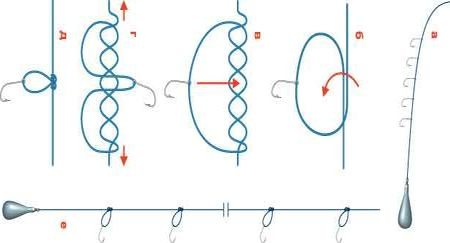
I would also like to mention wobblers and jigs. These baits can also be successfully used for fishing in the open sea. Bonito and garfish are bitten on floating wobblers, both when casting and trolling. But still, we use wobblers much less often than jigs, since vertical lures from the bottom are sometimes not inferior in efficiency to jig fishing. In any case, a fisherman should have several of these baits in his arsenal, since at heart any angler is an experimenter. The second rod, as I already said, is intended for fishing with multi-hook tackle. In general, I consider fishing for tyrants to be purely amateur fishing. I think many fishermen will disagree with me, considering this type of fishing quite sporty (by the way, competitions for this type of fishing are sometimes held on the Black Sea coast), but personally I cannot classify gear with several hooks as sports gear. But today we are not talking about that. To mount the stake, you will need hooks with a diameter of 8-10 (according to the international classification) with a long shank and a ring, which must be shiny, i.e. silver (bronze and other dark colors will not work), fishing line (monofilament, preferably transparent, blue or greenish, from a diameter of 0.22 to 0.30 mm), cambrics or beads (optional) and sinkers weighing from 50 to 100 g. Where does this name come from - tyrant? What is another name for tackle with bare hooks on which the fish “hangs” of its own free will? Of course, you can use a nozzle, which in some cases is simply necessary for catching certain types of fish, for example, weasel, mullet or goby. Shrimp and fish meat are most often used as bait. The picture shows that the bet is not a tricky installation, and I think for most anglers making it will not be difficult. By the way, ready-made stakes are available in almost any local fishing store, and the price for them is low, since they are considered a consumable item, like leashes for float fishing.
Choosing a fishing boat
A good boat should be easy to sail and maneuverable. In this case, it will not be difficult for you to reach the chosen place and stand on it accurately.
It is better if the boat has low sides. It is more convenient to fish from such a craft. A boat with high sides sails too much in the wind, and due to constant rocking, the pleasure of fishing will be completely destroyed.
It is good to have two anchors on the boat, one of which is located at the bow and the other at the stern. In this case, it will be possible to anchor securely at the chosen point, and the boat will not sway from side to side. This is important for ease of fishing and for good catches.
Bundles of stones or cast iron blocks can be used as anchors. The optimal weight is 5–10 kilograms. It is selected depending on the strength of the current and the wind.
If the weight is insufficient, the boat will be dragged by the flow of water. If it is too large, the anchor will be difficult to raise. There is also a chance that it will get stuck tightly in the soft muddy bottom, and you will have to cut the rope.
After fishing, be sure to take out the anchors so as not to clog the pond. If the load is firmly stuck in the mud, try to gradually wiggle it to get it out. This method helps even in seemingly hopeless situations.
It is better to secure gear holders on the sides of the boat. In them, the side fishing rods can be securely fixed after casting, and then all you have to do is calmly wait for the bites.
Fishing with holders is very convenient. They can be purchased at a fishing store or made with your own hands.
Preparation and basic rules
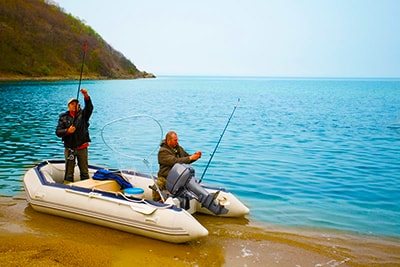
Summer fishing differs from autumn in its hot climate and bite, which is weaker than in autumn. Therefore, for an avid fisherman, autumn is a time of unique excitement and solid catches. And the first thing to remember is the rules of behavior on the water.
For recreational fishing from land, all you need to do is inspect the coastline. When doing boat fishing, you should remember the following rules :
- do not overload the boat and correctly calculate the number of people, each model has its own strictly defined carrying capacity; when the water is rough, the boat may be flooded with water;
- A watercraft that has hull damage and is not equipped with life-saving equipment is a direct threat to your life! Prepare her, do not neglect this advice; if you have a license to operate a small boat, take it with you;
- check the condition of the motor, transom board, oars and their fastenings.
- If you go out in conditions of very limited visibility, be sure to equip your boat with warning lights.
- Do not go out on the water if there is a thunderstorm or strong wind!
Before choosing a fishing spot, check your gear to make sure you haven’t forgotten anything. If you choose a boat, choose a larger vessel. It is much more stable, you can build additional canopies, you can move around the ship without knocking over or turning anything over. Equip the boat with devices with which you can secure your gear. Try to isolate areas where the fishing line or hook might get caught. Take poles (long wooden sticks) with you. You will need them to secure the boat at the fishing spot. Experienced fishermen have several places and stakes already on the water.
Choosing a fishing spot
It is better if the depth at the fishing spot is at least 3–4 meters. In shallower areas, fish tend to be afraid to get close to the boat. You can successfully fish from a boat in shallow water with a depth of less than 3 m at night.
The best areas for fishing with side rods are standard promising fishing spots:
- eyebrows;
- pits;
- shell rocks;
- snags.
To quickly find a promising place in an unfamiliar water area, an echo sounder will come in handy. With it you can quickly identify points with noticeable differences in depth.
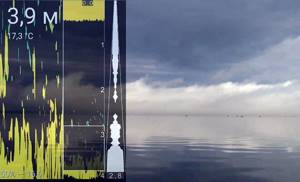
To cope with this task faster, it would also be useful to navigate by the features of the coast, since the bottom relief is a continuation of the coastal one.
The found promising points should be recorded in the memory of the GPS navigator so that they can be easily found in the future. Another option is to use the “old-fashioned method”: place beacons on discovered promising areas.
To make such a beacon, you need to tie a sinker to one end of the fishing line, and a float to the other, which is clearly visible on the surface of the water. A plastic bottle or other suitable object can serve as a float.
Fishing technique and choice of location
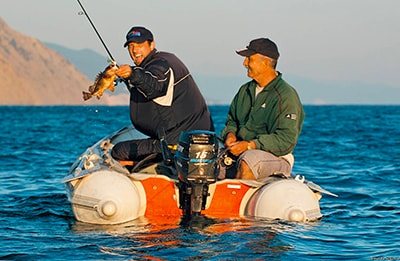
You have completed all the necessary preparations, checked everything and selected a reservoir. Your comfort and success of the planned event depends on the quality of preliminary preparation. Try not to fish in unfamiliar areas; choose places where you have already studied the bottom topography and underwater currents.
So, you're out on the water. When choosing a place for fishing, always remember the benefits that a successful catch will provide you with. Such a place should be quiet, away from shipping routes. If you are fishing in a river where there is a current, then position the boat across the current so that the line does not intersect or get tangled. Have you found your place, or are you staying in your old one? Check or install poles. They are installed taking into account the position of the boat relative to the current, the sun or the shore. Secure the boat and you can start preparing for the fishing itself.
Additionally, special devices for feeding fish are placed on the poles. Feed periodically to attract fish. But don’t overdo it, as well-fed fish don’t need your bait. If the bite in your reservoir is associated with the massive movement of fish, you should change the place when the bite stops.

Study the periods of fish migration : remember the duration and the next occurrence of a bite.
The analysis you made will be very useful next time. Do not forget the basic safety precautions: it is forbidden to fish along shipping lanes, waves left by ships can capsize the boat; Avoid potentially dangerous places - whirlpools and rapids. Do not choose a place near steep cliffs, do not place the boat under the edges of the bridge. It is advisable that you are always within viewing distance. Another condition for maintaining safety is equipping the boat with signal lights at night and during heavy fog. If you are fishing near shipping lanes, this measure will make the boat visible to passing vessels. But if you hear a ship approaching, stand up, take the flashlight in your hands and make circular movements. This is a generally accepted warning signal for all vehicles approaching each other.
Separately, we need to remind you about fishing near places that pose a potential danger. Such places include rescue stations, piers and water discharge points at power plants. Stations and berths are connected to the movement of speedboats; remember: the boat is not a car and will not be able to brake sharply.
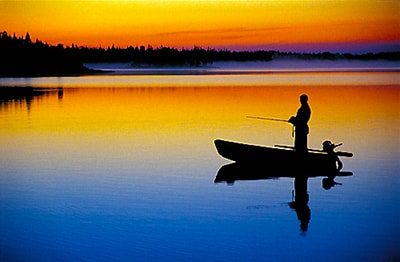
Choose places that do not overlap with the rescuers' exit. In places where water is discharged, temperatures are high all year round. The release of water raises the entire nutrient medium, so the fish are constantly “on duty” near these places. The bite here is always better than in other places in the reservoir. Do not try to get close to such places, as there are no warnings about the release of water. When released, the water bubbles up violently and can sink your boat.
Feeding
When fishing with an onboard fishing rod from a boat, it is convenient to use a feeder. A mesh bag with a mesh size of about a centimeter is suitable for this purpose. In addition to the bait, you need to put a lead sinker, a stone or another suitable object inside.
You need to tie a rope to such a feeder. At the beginning of fishing, it is lowered into the water, then the cord is attached to the side of the boat. The food is gradually washed out of it, attracting fish.
To fill such a feeder, a mixture of solid and small components - for example, cake, wheat and crackers - is best suited.
If bait balls are used, it is important to first anchor the boat securely so that the current cannot carry it a meter away, and only then throw the feed mixture into the water.
If the hook with bait is located away from the feeding table, this will significantly affect the results of fishing with an onboard fishing rod.
The closer the nozzle is to the bait, the more bites there are. If the hook with bait leaves the feeding table or moves away from the feeder, the fish bites worse.
Features of catching bream from a boat in the current
Catching not only bream, but also other types of fish using boats provides some advantages over coastal types of fishing. Using a boat, you can fish large areas of a reservoir and select the most promising place in the reservoir for catching bream from a boat.
When catching bream from a boat in the current, the fisherman will not be disturbed by all kinds of vegetation in the reservoir; there is no need to carry out long-distance casting processes, because you can easily swim closer to the desired fishing area. At the same time, boat fishing allows you to more effectively use a device such as an echo sounder. In addition, with this type of fishing process, the fisherman can choose which of the gear is most suitable for catching bream in the current.
And in the middle of the river you can catch much larger representatives of the bream family than when fishing for this fish on the shore. The only drawback of such fishing is the need to buy the boat itself, and nowadays this is not such a cheap pleasure.
Fishing technique
There are two options for fishing techniques from a boat using an onboard fishing rod:
- for standing tackle;
- for the game.
To fish with standing tackle, you need to throw the equipment into the water, fix the fishing rod on the side of the boat and wait for bites. This way you can use one or two fishing rods.
Another fishing rod is worth playing with at the same time. Sometimes bream or other fish prefer a standing bait, sometimes a bait on a wire.
The main version of playing with a side fishing rod is similar to playing with a jig tackle when fishing for devil or balda in winter.
You need to lower the bait to the bottom, and then, shaking the tackle up and down, gradually raise the fishing rod to a distance of half a meter to one and a half meters from the ground.
If the waves are rocking the boat, the bait on the hook of a standing tackle cannot remain motionless. She will also be rocked. This is an additional attractive factor for fish.
The first bites usually begin 10–30 minutes after the start of fishing. At first you come across a small fish, it could be a roach or a silver bream.
Then more interesting specimens approach the point - bream, ide, large roach and other fish.
Expert opinion
Vladimir Poltoranin
Fisherman - expert
If there are no bites, you can either change the nozzle or play with the equipment if you used to fish with standing tackle. Sometimes just moving the rod can quite easily entice the fish to take the bait. If there are no bites for more than an hour, it makes sense to change the place.
If the bite, on the contrary, is very active, there is a reason to leave only one tackle and exhaust the rest. In this case, you will have time to detect every trophy and will not miss a single one.
Fishing of different horizons
In mid-summer, when the thermocline occurs, even typically bottom-dwelling fish such as bream rise.
For example, when fishing at a depth of 10 meters, bites can occur 5–6 meters from the bottom. Therefore, if there are no bites in the bottom layer, it is worth checking other horizons.
To do this, you can put a long leash, about a meter, and put a foam ball on the hook in addition to the nozzle. When fishing with a side fishing rod with such equipment, the sinker will lie on the bottom, and the bait will rise higher.
Biting, hooking and fishing
Bites when fishing with a side rod from a boat are usually fast and energetic. They are very different from the bites that are typical for fishing with a fishing rod with a nod from the ice in winter, when the fish are passive.
It's hard not to notice them. The guard either quickly bends down or rises up. When fishing for the game, a bite may look like a malfunction of the guard.
Fishing does not cause problems. You need to gradually pull the fish towards the boat, without forcing things too much and without giving any slack (not allowing the line to sag).
There are two options:
- Land the fish while holding the line with your hands. After hooking, you need to take it with your left hand, lift it up, intercept it with your right and then act with both hands alternately.
- Pump out fish with a fishing rod. You need to lift it up and then lower it, while reeling in the fishing line. This operation is repeated until the trophy approaches the boat.
When the fish appears on the surface, you can either grab it by the gills with your hand or bring it into the landing net. Most experienced fishermen do without a landing net.
But, if you are not confident in your abilities, you can take a landing net with a short handle into the boat. When fishing with it, the chances of losing the trophy at the final stage of fishing will be much less.
If you are fishing for fish without a fishing rod and without a landing net, after you have taken the trophy from the water by hand, the main thing is not to drop it on the fishing line folded in the boat. If this happens, tangling of the rig is almost guaranteed.
Fishing with a fishing rod on the river from a boat
In the summer heat, bream and carp in rivers and reservoirs often concentrate at great depths far from the shore, where it is impossible to reach with a feeder. The departure of fish from the shore is also observed when the water level quickly drops, which is also often found on regulated large rivers. In such conditions, a boat will help you get to the fish.
Tackle for fishing from a boat
Fishing with side rods or a feeder from a boat can be problematic. Rocking, waves, and wind make it impossible to track weak bites when the fishing technique involves constant tension on the line. But springs and other donks have a mediocre response to fish bites that eat food in them.
But when fishing from a boat, you can also use a regular match fishing rod. As long as the conditions do not interfere with fishing with a float.
The possibility of using a float rod is determined by the depth of fishing and the strength of the current. As these factors increase, an increase in load will be required to counter the windage of the line. But it is impossible to endlessly increase the mass of the equipment, since it will become insensitive, and the meaning of using float equipment will be lost. For example, float gear will be effective for very weak currents at depths of up to 12 meters.
Use fishing rod
If the depth is not great (up to 4 meters) and the current speed is low, then you can try to catch it in one fell swoop. But tackle with a reel is still preferable on the river. Since with a reel you can always give up a few meters in case of demolition of the float or boat. And you shouldn’t lose the opportunity to fish with a long line release, because this is a very effective method.
Therefore, the optimal choice of gear for fishing from a boat is a 3-4 meter rod, feeder or match, it makes no difference, equipped with a high-quality inertial reel. It is also possible to fish with a non-inertial fishing rod, but it is somewhat more difficult. At very shallow depths, a fixed float can also be used. But mostly sliding floats are used.

Methods of fishing with a fishing rod from a boat
- Chassis. This is very active fishing. It is necessary to survey and fish large areas in search of active fish. You will have to fish at different depths, while looking for interesting and unusual terrain. If a promising place is found, then you can stop and feed. Surveying large areas still seems to be the best option when searching for and catching bream.
- Stationary. This is the main method of fishing on the river from a boat, since it is better to decide on a place in advance and then fish it at dawn. Here the casting point or wiring route is already determined. The place is feeding. The boat is secured with guy wires.
Selecting a location
It is advisable to use an echo sounder, which will allow you to find a school of active fish and determine the bottom topography. But if you don’t have a device, you can measure the depths with the same fishing rod, attaching a larger weight to the hook - a depth gauge. A promising place is a deep edge slope. Or the edges of a hole.
To be able to supply bait to such places on large rivers and reservoirs, you will need a boat.

Equipment Features
The weight of the equipment, and therefore the choice of float, will directly depend on the speed of the current, the depth of fishing, and also on the diameter of the fishing line. Floats from 12 grams are most often used. But in favorable conditions, you can switch to thinner fishing lines, which means more sensitive equipment - 5 - 10 grams. You can select the optimal weight of equipment and load distribution only for specific conditions, guided by your own experience of fishing with a match fishing rod.
It is necessary that the float does not lie on its side when it is held during retrieval, and also that it does not sink if anchored with a sinker at the bottom. The usual option for equipping a fishing rod for fishing from a boat in weak currents, but at great depths, looks like this.
Sliding waggler
The float is a sliding waggler with a floating antenna and one attachment point, 12 grams. It is desirable that the float has an adjustable own load. Then it will be possible to increase the mass of the load on the fishing line as the flow speed increases. For example, on the float - 4 grams and on the fishing line - 8 grams. The antenna should be thicker - with significant buoyancy of its own, which will have a positive effect when the mass of the bait changes - the float will sink, but will not go completely under water.
Loading scheme
The main load is used in the form of an olive attached to a fishing line with a pair of cambrics. The feeder is divided into 3 weights, which can be moved along the fishing line and thereby regulate the possibility of anchoring the equipment at one point. Also, this circuit will allow you to adapt to the desired wiring without rewiring. The float is loaded in such a way that its entire floating body and a small part of the antenna are under water.
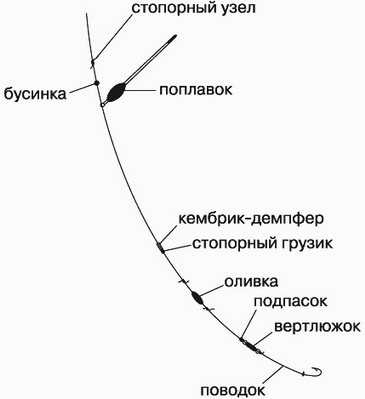
Leash
The leash is usually made from fishing line with a diameter of 0.11 - 0.12 mm. This diameter will be sufficient to count on landing a heavy trophy, and at the same time not greatly increase the windage. When fishing, it is extremely important to keep the line close to the vertical, especially when baiting. After all, most bites should be expected when the hook is no further than 1 meter from the bait spot downstream. Therefore, the main attention is on windage and the degree of load. The length of the leash can vary within a very wide range depending on the wiring and reach 1.5 meters.
Line and hook
The main line is match sinking, with a diameter of up to 0.14 mm.
Hook. The size of the hook depends on the size of the bait. It is advisable to prepare leashes for worms and maggots, i.e. for baits, which are mainly used for fishing on the river.

Lure
It is best to get a 2-3 meter long stick equipped with rings and a reel to deliver bait in a net. This will allow you to lower the bait not at the very side of the boat, and will give you more maneuverability in choosing the feeding point.
The quantity and viscosity of bait directly depends on the flow speed. So, in a very weak current, a voluminous winter feeder is enough, into which, for starters, you need to place a kilogram of food. The required ingredients for bream are a handful of chopped worms, a handful of maggots and a glass of millet porridge.
For strong currents, weighted mesh feeders are used, designed for 5–6 kg of feed, which is gradually washed out, forming a feeding path. Or the bait is thrown in hard-to-wash balls.
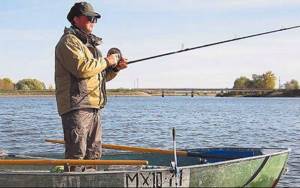
Fishing technique
Wiring can be either with a bait floating near the bottom, or with dragging the bait along the bottom. The swimming trajectory is determined by the location of the food and the direction of the current. The cast is usually made 5-10 meters upstream from the feeder, so that the hook has time to fall to the stern.
If bites occur at the same point, then it makes sense to anchor the rig on it using a heavy rig (moving all the rigs towards the hook).
Retrieving techniques that involve holding the rig with a rod are also effective. In this case, the leash may float up in the current. Periodic holding attracts fish. And with a long leash, this technique can be very successful, since it simulates the free passage of food in the water column at the bottom. Experiments with wiring when the bite stops at one point usually give excellent results, especially in the size of the fish caught.
Boat installation
If you decide to fish in an open area near a coastal dump, then the boat should be installed on two anchors on ropes. It is very important to monitor the strength and direction of the wind and current. The weight of anchors can directly depend on these factors. The main thing is that the boat does not drift and that the anchors hold it well. When fishing on quiet rivers or lakes, place the boat so that the wind blows to its side. Anchors are cast from the edge of the boat. If fishing takes place in areas with muddy currents, then the boat is positioned so that the bow is directed against the current.
Bait for bream from a boat
Catching bream from a boat requires good bait; without it, it will be difficult to achieve the desired results. But, as practice shows, bait alone is not enough. It would be advisable to target bait, in small portions and quite often. For the first feeding, do not skimp on the bait, add a lot of it. Then feed the bait at certain intervals, gradually reducing the portions. Most fishermen prefer makukha and semolina as the basis for bait. Often, bait is mixed with clay, this allows it to last longer in the current and not oversaturate the fish.
Having a landing net is a prerequisite for catching bream from a boat. There is nothing very difficult about fishing for bream, but you shouldn’t treat it as a routine activity. The bream, having seen the angler, makes the last couple of jerks and very often it is thanks to these jerks that it gets back to its native element.
prorybu.ru

